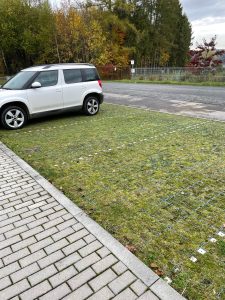Storytelling shapes our consumer behaviors, directing our choices in services and products, revealing the role of stories in establishing brand…
Tekijät | Authors

Nature-Based Solutions to Water Management
Urban water management presents many and varied challenges to communities and city planners around the world. Increasingly, nature-based solutions (NbS) are being introduced to solve these challenges, offer amenity services, and combat climate change. NbS are described by IUCN as interventions which leverage nature and the power of healthy ecosystems to protect people, optimise infrastructure and safeguard a stable and biodiverse future.

Figure 1: Phyto-Parking in allows for more sustainable stormwater management in areas where no additional land is available and no excavation is allowed, for example due to planning restrictions to protect heritage assets. (Joe Perry, 2022)
The Water and Environmental Engineering Team (WET) at Turku UAS is delivering the Intelligent and Sustainable Stormwater Management (ISMO) project, which aims to enable the efficient upscaling of sustainable natural stormwater solutions (ISMO project 2022). While this project is based in the southwestern Finnish city of Turku, it will produce transferable lessons and data which can be applied to a variety of contexts.
The “wicked water problem”
The “water problem” facing communities around the world is considered “wicked” on account of it being difficult to solve due to incomplete, contradictory, and changing conditions. Wicked problems can be socially complex and economically challenging and often disproportionately affect the most vulnerable communities.
Each of the below “snapshots” highlights a water management case study from around the world. In each case, a challenge is presented, a nature-based solution offered, and a lesson presented for the ISMO project.
Snapshot #1: Lack of public engagement
Challenge: Lack of public engagement with local NbS to water issues and a lack of community co-creation.
Solution: Accessible community engagement at an early stage and a NbS design structure which allows for meaningful contributions from local communities.
Case Study: Start Park in Italy is an organization which seeks to answer the question “how might citizens and local actors contribute to raising a city’s resilience to tackle the increasingly frequent extreme climate events (from droughts to intense rainfall)?”. Start Park offers a systematic service that merges public and private interest and facilitates the growth of resilient urban parks and shared awareness about the climate crisis.
Lessons for ISMO project: Co-creation in urban blue/green infrastructure increases public support for local projects, attracts investment and improves delivery and maintenance of infrastructure.
Snapshot #2: Lack of understanding and awareness
Challenge: A lack of understanding and awareness of NbS to water management among city leaders.
Solution: A clear framework for addressing urban circularity challenges with NbS.
Case Study: The COST Action Circular City Framework includes an illustrated catalogue of technologies for providing and/or recovering resources with NbS (see illustrated example in figure 2 and glossary table in figure 3). This framework describes practical NbS in an accessible format. Its target audience is municipal decision makers and construction companies and it is written and illustrated in a manner requiring little pre-existing knowledge.
Lessons for ISMO project: 1) different stakeholders may have different interpretations of the meanings and uses of the same NbS. 2) technical terminology can create barriers for collaboration on NbS between stakeholders.
Snapshot #3: Competition for space in the cities
Challenge: Competition for space and the high land footprint of some NbS.
Solutions: Innovations, such as aerated wetlands, which can reduce the footprint of the NbS by 2-5 times (see figure 5).
Case Study: The College of Engineering in Pune, India has employed urban greening as a space-efficient solution to grey water management. Grey water from the Hostel Campus building filters through an on-site NbS, before being recycled back into the building (see figure 5).
Lessons for ISMO project: Innovative use of space can make NbS more attractiveto key stakeholders, such as city planners, developers and local communities. Stakeholders do not necessarily need to choose between NbS and other urban amenities.

Figure 3: Aerated wetland (Lyon University, 2022)

Figure 4: Urban Greening solution in Pune, India (Lyon University, 2022)
Snapshot #4: Legal restrictions
Challenge: Legal restrictions due to safe water quality standards.
Solution: Innovative legislation, informed by research and community engagement.
Case Study: EU regulation for treated wastewater reuse in agriculture (2020/741). This change to EU agricultural legislation aims to alleviate climate change related water scarcity by encouraging water reuse in agricultural irrigation. The legislation facilitates the uptake of water reuse, without compromising human health and environmental protection.
Lessons for ISMO project: Policy and legislation are constantly evolving, and research groups play a pivotal role in providing the knowledge base for increased sustainability and efficiency.
Conclusions
Water management will continue to present challenges to communities and city planners across the world. Rapid urbanization, a changing climate and population increase may exacerbate these challenges, but also provide a dynamic context within which innovative and sustainable water management can protect people and planet.
Collaboration and knowledge sharing are valuable tools in sustainable stormwater management. The case studies outlined in this blog offer valuable data and reveal the common challenges
Turku UAS’s ISMO project will be part of the solution, by driving innovative and sustainable water management in the Turku region and beyond through close collaboration with the stakeholders, improving the management and sharing of stormwater data, and by utilizing digital twin technology and advanced water monitoring approaches.
References
About nature-based stormwater solutions (2022) Ismo. Available at: https://ismo.turkuamk.fi/en/about/ (Accessed: October 24, 2022).
Accueil: INRAE instit (2022) Accueil | INRAE INSTIT. Available at: https://www.inrae.fr/ (Accessed: October 24, 2022).
Atanasova, N. et al. (2021) “Nature-based solutions and circularity in cities,” Circular Economy and Sustainability, 1(1), pp. 319–332. Available at: https://doi.org/10.1007/s43615-021-00024-1.
Bernhard and Helga (2022) Circular City. Available at: https://circular-city.eu/ (Accessed: October 24, 2022).
Castellar, J.A.C. et al. (2021) “Nature-based solutions in the urban context: Terminology, classification and scoring for urban challenges and Ecosystem Services,” Science of The Total Environment, 779, p. 146237. Available at: https://doi.org/10.1016/j.scitotenv.2021.146237.
Cost Action Circular City (2020) YouTube. YouTube. Available at: https://www.youtube.com/watch?v=R3NXLb-W1pg (Accessed: October 24, 2022).
European Parliament, Council of the European Union (2020) Official Journal of the European Union. Brussels . Available at: https://eur-lex.europa.eu/legal-content/EN/LSU/?uri=CELEX:32020R0741.
Langergraber, G. et al. (2021) “A framework for addressing circularity challenges in cities with nature-based solutions,” Water, 13(17), p. 2355. Available at: https://doi.org/10.3390/w13172355.
Towards circular cities special issue: Blue-Green Systems: IWA Publishing (2022) Towards Circular Cities Special Issue | Blue-Green Systems | IWA Publishing. Available at: https://iwaponline.com/bgs/pages/towards_circular_cities_special_issue (Accessed: October 24, 2022).








